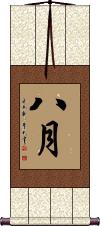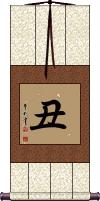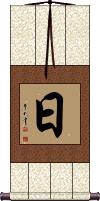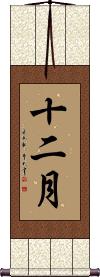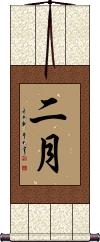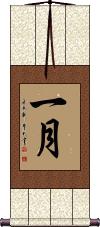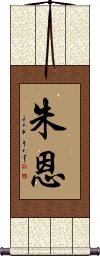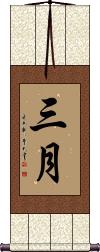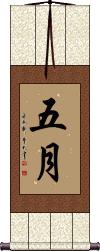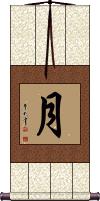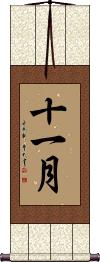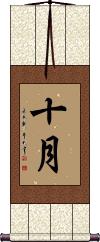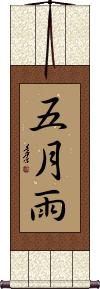Many custom options...
And formats...

Month in Chinese / Japanese...
Buy a Month calligraphy wall scroll here!
Personalize your custom “Month” project by clicking the button next to your favorite “Month” title below...
1. April
2. August
4. Chou
5. Day
6. December
7. February
8. January
9. July
10. June
11. Month of March
12. The Month of May
13. Moon
14. November
15. October
16. Samidare
17. September
18. Sun / Solar
April
Fourth Month
This is April in Chinese, Japanese Kanji, and old Korean Hanja.
This was originally the fourth month of the Chinese lunar year, now used for the fourth month of the Gregorian calendar (also known as the Western or Christian calendar). 四月 literally mean “fourth month” or “fourth moon.”
August
Eighth Month
八月 is the month of August in Chinese, Japanese Kanji, and old Korean Hanja.
八月 literally means “eighth month” or “eighth moon.”
In Japanese, this can also be the female given name, Yatsuki, in much the same way August can be a female given name in English.
August
Broken Mirror Rejoined
Used in modern times for divorced couples that come back together
破鏡重圓 is about a husband and wife who were separated and reunited.
About 1500 years ago in China, there lived a beautiful princess named Le Chang. She and her husband Xu De Yan loved each other very much. But when the army of the Sui Dynasty was about to attack their kingdom, disposed of all of their worldly possessions and prepared to flee into exile.
They knew that in the chaos, they might lose track of each other, so the one possession they kept was a bronze mirror which is a symbol of unity for a husband and wife. They broke the mirror into two pieces, and each of them kept half of the mirror. They decided that if separated, they would try to meet at the fair during the 15th day of the first lunar month (which is the lantern festival). Unfortunately, the occupation was brutal, and the princess was forced to become the mistress of the new commissioner of the territory, Yang Su.
At the Lantern Festival the next year, the husband came to the fair to search for his wife. He carried with him his half of the mirror. As he walked through the fair, he saw the other half of the mirror for sale at a junk market by a servant of the commissioner. The husband recognized his wife's half of the mirror immediately, and tears rolled down his face as he was told by the servant about the bitter and loveless life that the princess had endured.
As his tears dripped onto the mirror, the husband scratched a poem into his wife's half of the mirror:
You left me with the severed mirror,
The mirror has returned, but absent are you,
As I gaze in the mirror, I seek your face,
I see the moon, but as for you, I see not a trace.
The servant brought the inscribed half of the mirror back to the princess. For many days, the princess could not stop crying when she found that her husband was alive and still loved her.
Commissioner Yang Su, becoming aware of this saga, realized that he could never obtain the princess's love. He sent for the husband and allowed them to reunite.
This proverb, 破鏡重圓, is now used to describe a couple who has been torn apart for some reason (usually divorce) but have come back together (or remarried).
It seems to be more common these days in America for divorced couples to reconcile and get married to each other again. This will be a great gift if you know someone who is about to remarry their ex.
Chou
丑 can refer to the astrological time of the ox, or a Chinese surname, Chou.
丑 represents the 2nd earthly branch. In daily time, 1:00-3:00 AM, or the 12th/last month in the Chinese calendar.
In an ancient year-naming scheme, this can represent the year of the Ox (one of twelve animals paired with one of five element characters yielding a 60-year cycle).
This is how to write “day” in Chinese, Japanese, and Korean Hanja.
This can also mean “Sun,” the star in the middle of the Solar system in which we live. In Japanese, it can also mean “sunshine” or even “Sunday.”
When writing the date in modern Chinese and Japanese, putting a number in front of this character indicates the day of the month. Of course, you need to indicate the month too... The month is expressed with a number followed by the character for the moon. So “three moons ten suns” would be “March 10th” or “3/10.”
Note: This is also the first character for the proper name of Japan. Remember that Japan is “The land of the rising sun”? Well, the first character for Japan means “sun” and the second means “origin” so you get the real meaning now. Sometimes, in China, this sun character can be a short name for Japan or a suffix for something of or from Japan.
December
Twelfth Month
十二月 is December, the twelfth month of the year, in Chinese, Japanese Kanji, and old Korean Hanja.
February
二月 is the Chinese, Japanese Kanji, and old Korean Hanja for the month of February.
This literally means the “second month” or “second moon” (of the year).
January
First Month
一月 is the month of January, the first month of the year, in Chinese, Japanese Kanji, and old Korean Hanja.
July
Seventh Month
七月 is how Chinese and Japanese express July (also used in old Korean Hanja).
七月 literally means “seventh month” or “seventh moon.”
June
June
June
Sixth Month
This is the month of June in Chinese, Japanese Kanji, and old Korean Hanja.
This was originally the sixth month of the Chinese lunar year, now used for the sixth month of the Gregorian calendar (also known as the Western or Christian calendar). 六月 literally mean “sixth month” or “sixth moon.”
Month of March
Third Month of the Year
三月 is the Chinese, Japanese, and Chinese way to write the month of March.
This literally reads as “third month” or “third moon.”
The Month of May
Fifth Month
五月 is the month of May in Chinese, Japanese Kanji, and old Korean Hanja.
This was originally the fifth month of the Chinese lunar year, now used for the fifth month of the Gregorian calendar (also known as the Western or Christian calendar). 五月 literally means “fifth month” or “fifth moon.”
Note: Sometimes Japanese parents will use this as a female given name, and use "Mei" (the sound of May in English) as the pronunciation.
Moon
月 is how to write the title for “moon” in Chinese, Korean Hanja, and Japanese Kanji.
月 is also used to refer to the month. This is because China traditionally uses a lunar calendar, so saying “next moon” is the same as saying “next month” etc.
In modern Chinese and Japanese and old Korean, the character for a number is put in front of this moon character to represent western months. So “one moon” is January “two moons” is February etc.
If you are wondering, in the east Asian way to write dates, the character for “sun” or “day” is used with a number in front of it to express the day of the month. So “ten moons, one sun” becomes “October 1st” or “10/1” (this date happens to be Chinese National Day - The equivalent of Independence Day in the USA, Canada Day, or the Queen's Birthday).
In Japanese, 月 can be a surname that romanizes as Tsuki, Tsukizaki, or Takagetsu.
November
Eleventh Month
十一月 is the Chinese, Japanese, and old Korean title for the month of November.
This literally means the eleventh month or moon.
October
Tenth Month
十月 is how Chinese and Japanese express October (also used in old Korean Hanja).
十月 literally means “tenth month” or “tenth moon.”
Samidare
September
Ninth Month
九月 is the Chinese, Japanese Kanji, and old Korean Hanja for the month of September.
Originally this was for the ninth month of the lunar calendar, now used for the western (Gregorian) calendar.
This can also be the Japanese female given name Kugetsu.
Sun / Solar
Also means Day, Sunshine, Sunlight, or Japan
日 is the word for sun.
It also means day and can refer to the day of the month when expressing the date.
Example: October 1st would be “10 Moons, 1 Sun.”
日 is also the first Kanji for the title of Japan (in Chinese, Japanese Kanji, and Korean Hanja). Thus, this character is used as an adjective for things that are Japanese.
Ever heard of Japan being called, “The land of the rising sun”? Well, that's what the full title of Japan means.
Depending on the context, this character can mean Sunshine or Sunlight.
Note: In Japanese, this Kanji has a variety of possible pronunciations. The pronunciation changed depending on context and how this Kanji is combined with other Kanji. When used alone, this is usually "hi" (pronounced like "hee") but sometimes it’s "nichi." When combined, it can be "tsu," "ni," "ka," and a few others.
The following table may be helpful for those studying Chinese or Japanese...
| Title | Characters | Romaji (Romanized Japanese) | Various forms of Romanized Chinese | |
| April | 四月 | shi gatsu / shigatsu | sì yuè / si4 yue4 / si yue / siyue | ssu yüeh / ssuyüeh |
| August | 八月 | hachigatsu / yatsuki | bā yuè / ba1 yue4 / ba yue / bayue | pa yüeh / payüeh |
| August | 奧古斯特 奥古斯特 | ào gǔ sī tè ao4 gu3 si1 te4 ao gu si te aogusite | ao ku ssu t`e aokussute ao ku ssu te |
|
| Broken Mirror Rejoined | 破鏡重圓 破镜重圆 | pò jìng chóng yuán po4 jing4 chong2 yuan2 po jing chong yuan pojingchongyuan | p`o ching ch`ung yüan pochingchungyüan po ching chung yüan |
|
| Chou | 丑 | chuu / chu | chǒu / chou3 / chou | ch`ou / chou |
| Day | 日 | hi / nichi | rì / ri4 / ri | jih |
| December | 十二月 | juu ni gatsu juunigatsu ju ni gatsu | shí èr yuè shi2 er4 yue4 shi er yue shieryue | shih erh yüeh shiherhyüeh |
| February | 二月 | futatsuki / nigatsu | èr yuè / er4 yue4 / er yue / eryue | erh yüeh / erhyüeh |
| January | 一月 | ichi gatsu / ichigatsu | yī yuè / yi1 yue4 / yi yue / yiyue | i yüeh / iyüeh |
| July | 七月 | shichigatsu | qī yuè / qi1 yue4 / qi yue / qiyue | ch`i yüeh / chiyüeh / chi yüeh |
| June | 君 | jūn / jun1 / jun | chün | |
| June | 朱恩 | zhū ēn / zhu1 en1 / zhu en / zhuen | chu en / chuen | |
| June | 六月 | roku gatsu / rokugatsu | liù yuè / liu4 yue4 / liu yue / liuyue | liu yüeh / liuyüeh |
| Month of March | 三月 | mitsuki / sangatsu | sān yuè / san1 yue4 / san yue / sanyue | san yüeh / sanyüeh |
| The Month of May | 五月 | satsuki / go gatsu satsuki / gogatsu | wǔ yuè / wu3 yue4 / wu yue / wuyue | wu yüeh / wuyüeh |
| Moon | 月 | tsuki | yuè / yue4 / yue | yüeh |
| November | 十一月 | juu ichi gatsu juuichigatsu ju ichi gatsu | shí yī yuè shi2 yi1 yue4 shi yi yue shiyiyue | shih i yüeh shihiyüeh |
| October | 十月 | juu gatsu / juugatsu / ju gatsu | shí yuè / shi2 yue4 / shi yue / shiyue | shih yüeh / shihyüeh |
| Samidare | 五月雨 | samidare | ||
| September | 九月 | kugatsu | jiǔ yuè / jiu3 yue4 / jiu yue / jiuyue | chiu yüeh / chiuyüeh |
| Sun Solar | 日 | hi / nichi | rì / ri4 / ri | jih |
| In some entries above you will see that characters have different versions above and below a line. In these cases, the characters above the line are Traditional Chinese, while the ones below are Simplified Chinese. | ||||
Successful Chinese Character and Japanese Kanji calligraphy searches within the last few hours...

